
The Blue Ridge Voyageurs
River Conservation
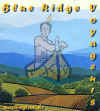
 |
The Blue Ridge Voyageurs River Conservation |
 |
Advantages of Canoes v. Kayaks:
24 Advantages of Open Canoes in Whitewater
This article by Northern California paddler Don Iverson first appeared in the Jan/Feb 2011 edition of the American Whitewater Journal. It is reprinted here with permission from AW and the author.
[Editor’s note: For decades, BRV’s canoeists and kayakers have occasionally chided each other over which type of craft/paddler is innately superior. Today, many people being introduced to river running aren’t old about the pros and cons of canoe vs. kayak by retailers and kayaking schools before choosing which craft to take up.
Below is one open boater’s humorous take on the debate. Got an opposing point of view? Write it up and we’ll post it here. Mike Martin, OC1]
Kayakers vs. Canoeists. Snowboarders vs. Skiers. Celtics vs. Lakers. Ironworkers vs. Teamsters. Aussies vs. Kiwis
These types of rivalries that occur between human breeds are a vestige of the tribal mentality that was once critical for survival. Within individuals, the intensity of the rivalry varies, depending on the relative contributions of healthy passion, innate hostility, self-affirmation through group identity, and egotism.
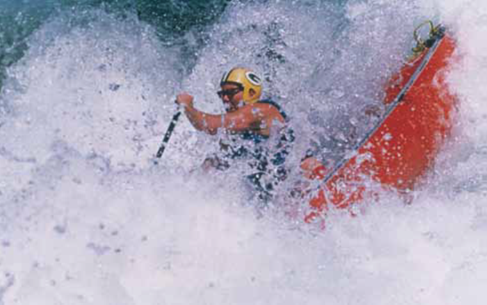 |
Don Iverson, South Fork Falls, South Fork Smith River, CA. |
Our friendly rivalry is properly characterized as “kayakers vs. canoeists” because kayakers have largely instigated and perpetuated it. The late William Nealy fired the first written salvo in his 1986 book Kayak, where he characterizes canoeists as “{thought to be} obnoxious and demented by most kayakers…insecure about the capabilities of their chosen river craft” and states that “it is the sacred duty of all kayakers to tease canoeists.”
With their marching orders and rules of engagement in hand, legions of kayakers waged battle around campfires all over North America. A typical scenario: a lone canoeist is innocently minding his own business, charitably darning socks for the homeless. A pack of kayakers, some disguised as friends, begin to circle him. He offers a few ingratiating remarks, which seem only to infuriate the mob. He then claims Federal protection under the Endangered Species Act, but to no avail, as the kayakers have already had several sips of their Chardonnay spritzers. Their heads spin; their lips loosen. But, mercifully, the advantages conferred by their greater manpower and bloodlust are neutralized by their predictable battle strategy and the availability of only three weapons in their lexicographic arsenal: “get a real boat,” “yeah, get a real boat,” and simply “yeah.”
The canoeist mentally formulates a cogent counterattack, but then recognizes that it would likely stupefy them as much as repeated explanations of how babies are made. He re-strategizes. A two-word retort should not overload their collectively delicate brain circuitry, he reckons, as long as the second word is “you.” Predictably, the discussion then degenerates into the same sort of increasingly loud, interruptive diatribe that is broadcast on news talk shows.
Screaming will not resolve this debate. Instead, a definitive resolution will require an objective, formal analysis; a concatenation of inductive logic, case-based reasoning from real world examples, basic Newtonian physics, human anatomy, and psychology. And, in order to sell more copies of American Whitewater, it should include some gratuitous SEX! and KAYAKER JOSHING!, which will be clearly labeled for the sake of the sensitive reader.
Before we get to that, a few conciliatory remarks. The company and support of kayakers has enabled me to pull off some of my most difficult runs. Across the continent, they have been generally friendly, treating me with appropriate amounts of curiosity, respect, and forgiveness. In fact, I probably owe my life to a kayaker—a big ol’ Appalachian stud whom I absolutely pile-drove, accidentally, while he was surfing on the Ocoee. He rolled up and, before I could begin groveling for my life, he laughed and let out a Rebel yell: “whoooowee, you really got me good!“ (See reasons #18 and 19—your craft as an offensive or defensive weapon). Furthermore, we must acknowledge that canoeists and kayakers have many more similarities than differences. We both share many facets of the paddling experience— the drive to the put-in, jamming to Jimi, Bob, Sly, Duke, or Bach, as fits to mood; the camaraderie and synergy of shared experience; the reverence for the splendor of the canyon; the ascendance into a state of flow, or “the zone;” the thrilling stoke of a clean run; the wisdom gained from understanding our motivations and limits; and the post-run afterglow.
But let’s not get too lovey-dovey here— this is a macho whitewater magazine, not “Oprah”. Although we have much in common, our differences, not our similarities, are what stratify us in animal hierarchy. And, with 24 evolutionary advantages of open canoeing, there can be no doubt as to which subspecies of paddler, although outnumbered, is truly the most highly evolved and dominant.
Reasons #1 & #2: Less risk of vertical pinning or leg entrapment
No joking here. A canoe’s bow has a much larger cross-section area than even the stubbiest creek boat, making it less likely to wedge into a crack or pothole [or stuffed under a log]. Secondly, open canoes do not have a deck that can collapse onto paddlers’ legs and entrap them. Enough said.
Reason #3: Don’t be a head-banging Kayaker
My kayaking buddies are better boaters than I am, but they still flip a couple of times per run, because their boats are tippier. Sure, they roll up, but only after their heads have been trawling awhile for rocks, logs, rebar, culvert, and other river detritus. Canoes are more stable and flip less; if they flip, the pilot can get his or her head above the waterline, beneath the gunwales, until it is time to roll. CAUTION, Gratuitous Kayaker Joke: Not just boaters, but society as a whole should take an active role in preventing head injury to kayakers. Kayakers are the ideal donors for brain transplantation, as their brains are essentially unused.
Reason #4: Shoulder the load
Canoeists principally rely on the low brace, which transmits force to their powerful chest muscles. Kayakers, however, dislocate their shoulders by high bracing, which transmits force to the much smaller muscles of the rotator cuff. A dislocated shoulder on a wilderness run is a major problem; unfortunately, dislocations tend to recur.
Reason #5:More comfort
Does anybody sit flat on their butt, with their legs out stretched, for any reason other than kayaking? The kneeling canoeist, on the other hand, has inspired the design of the computer chair, which combines sitting and kneeling. But we don’t just kneel—we can sit, stand, or recline onto our float bags. For a vision of heaven, form a canoe trimaran by draping your legs into the neighboring canoe, lie back on your airbag cushions, and float effortlessly as you gaze upward at the canyon walls.
Reason #6: Stay warmer
Because kayaks ride lower in the water, their pilots spend more time immersed than do canoeists. When the water is cold, you can get cold, which is a drag. Hypothermia, though, is serious. Numb hands drop paddles, cold muscles lose power, and cold brains have impaired reaction times, coordination, and decision-making capabilities. (For more on the deleterious effects of cold on cognition, see also “Minnesotan”).
Reason #7: See where you are going
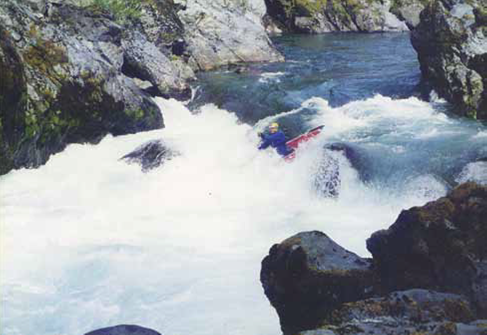 |
Don Iverson probes the depths of Bloomer Falls, Salmon River, CA. Photo by Tom Rydz |
Canoeists sit about two feet higher than kayakers, giving them better visibility. My kayaking buddies invoke this as a reason for me to go first when the river starts getting loud. But what if 24 inches aren’t enough? Picture this scenario:You are approaching the horizon line of “High Colonic,” a reputedly gnarly drop. It’s getting late, and scouting would be undesirably time-consuming. If only you could see the drop…. Just then, your canoeing colleague sits up, and then stands. Yes, she is standing in her boat! She peeks over the precipice, finds the line, and guides everyone to safety. Dang!
Reasons #8, 9, and 10: Go longer, go in better style, rescue a friend
Canoeists spawn in rivers or Northwoods lakes. So heroic is the Old Norse saga that its power only grows with each recital. A newly hatched canoe fry is with his father and grandfather, fishing from the damp bottom of a frigid aluminum canoe in the last November rain before freeze-up. The wind begins to howl, spraying whitecaps into the boat and piercing his soaked jeans and kapok life jacket. Not yet ready to enter Valhalla, the patriarch and his son paddle furiously into the blackening offshore gale, alternately imploring the grandson to bail, and taking Thors’ name in vain. Well after dark they reach shore, where they gorge upon muskie, walleye, and beer, comfort themselves with their Amazonian women, vanquish marauding hordes, etc.
After so many of these epics, the fingerling canoeist begins to contemplate the advantages of gravity for marine propulsion. Slowly, over the years, he or she works their way up from multi-day wilderness Class I and II runs to Class III , or higher.
Kayakers, on the other hand, spawn in swimming pools at the Tuesday night roll session. The combination of chronic chlorine exposure and genetic predisposition can result in questionable behavior. With a tenuous pool roll, they head for a Class III river. Here, their more experienced colleagues have conglomerated upon a single wave, comparing each others’ “twisting upenders,” or whatever. The canoeists’ heritage leads him or her away from these crowds and into the wilderness, where our souls breathe freely. A trip of 3 or 4 days refreshes; a trip of 3 or 4 weeks is a complete restoration. A trip of this length is out of the range of kayakers, unless they are willing to make the Faustian sacrifice of bringing a raft. As for shorter trips—why not go in style? If you spare us the sanctimony of the Alpine “fast and light” ethic while you eat your Ramen and bivy in the rain, we may share our steak, beer, or tent with you. Now, what if you lose a boat on one of these long trips, where hiking out is impossible? Unless you are a genetically engineered human/salmon hybrid, you had better hope that there is a canoe around to give you a lift to the take-out. Don’t laugh, it has happened.
Reasons #11, 12, and 13: Get more chicks/get a real man, and consummate in your boat
CAUTION:Erotic Interlude and Kayaker Joshing
Her hands deftly untie the last truckers’ hitch and she slides the battered canoe off of her 1957 International flatbed. As she readies her vessel for the day’s dance with the Earth Mother, the tranquility is momentarily perturbed by kayakers swarming around her. She remains grounded in her self-reliant goddessness as the little boaters attempt, in vain, to commence their primitive mating ritual with a fusillade of desperate pickup lines: “Uh, this is a whitewater run, babe;” “Dude, wanna check out my ink?” “Like, want some of my free-range tofu?” and so forth. A tight-lipped smile, and the boys are dismissed. But, within a heartbeat, her gaze warms. She is transfixed by a large form resembling Michelangelo’s David, version 10.0. He sets down his canoe and says, softly, “I’m by myself, may I join you?” Her eyes meet his, but then avert, for her feelings are suddenly too intense. She catches her breath to say, “I’m overnighting at the hot springs.” He smiles and nods. They take their boats and levitate down the riverbank.
Few words are spoken that day, nor need be. Together, they resonate with the rhythm of the river; their laughter and smiles reflect their Zen-like state of tranquil invigoration.
The decision to camp together goes unsaid. They feast, then bask in the glow of the day’s gift and the evening’s fire. She sings, her voice a mélange of Bonnie Raitt and Nina Simone. He rubs her shoulders and riffs on Shelly and Goethe.
In her eyes, he sees what is on his mind. They board her craft, which rocks sensuously in the moonlit eddy of the susurrating stream. From the confluence of their chakras’ wellsprings, the flowing ecstasy of their day is reincarnated, then transcended. As they evaporate into the night air all is bliss, all is bliss.
Reasons #14, 15, and 16 Get in, get out, get back in
Swimming is an eventuality for all boaters. The kayaker/swimmer has to sidestroke his boat to shore, while trying to overcome the sea-anchor effect of his spray skirt. Hopefully for him, the “shore” is not a mossy, undercut cliff. In the unlikely event of a canoeist swimming, however, he or she can just hop back in the boat via the wet entry, an impossible maneuver for a kayaker. It’s just that simple.: Now, say, a kayaker is approaching the horizon line of “Tenesmus,” a wicked, congested drop. He tries to attain the flushing shoreline eddy, pitons a guard rock, and flips. Now upside down and heading for doom, he begins to pray. He prays that his canoe buddy has successfully performed the maneuver that he has admired so many times before, but could never emulate. It is a dynamic move in which the canoeist simultaneously beaches his craft and leaps onto a rock, then grabs his boat, and anybody else’s who comes floating by. And this time the kayaker is in luck—saved by a canoeist! Now rescued, the kayaker and his savior have to re-enter their boats from their meta-stable location. No problem for the canoeist. He just hops back in and snickers as the kayaker performs a well-choreographed medley of the slippery rock moonwalk, the kayak-reentry limbo, and the spray skirt/paddle hand jive, all the while again drifting towards doom.
Reason #17: Keep on truckin’
Because they are larger and more stable crafts, canoes, like monster trucks, can roll over river features that may trip up a smaller kayak. Ski-jumping pour-overs and hole-punching in particular can be easier for canoes, especially with the additional inertia provided by any accumulated aquatic ballast. (While there may be theoretical disadvantages of said ballast, time and space do not permit a discussion of this abstract implausibility.)
Now, if the river feature in question is a kayak, then we are on to a whole other thing…
Reason #18: Your craft as an offensive weapon
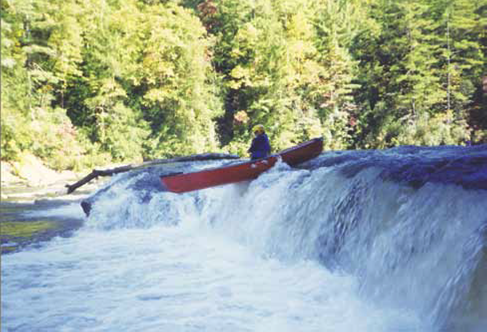 |
Picture yourself quickly approaching a kayaker cluelessly surfing downstream. You have no exit strategy. A collision is imminent. If you, too, are in a kayak, your odds of survival are about 50/50. But, if you’re packin’ 13 feet of Royalex and 800 pounds of water, spearheaded with jagged, chipped skid plates, then that kayaker is road kill! We canoeists call this a “flick,” as in: “How’d you get that pink scuff on your hull Don?” “Well, Tom, I guess I must have flicked that kayaker off of that last wave, har, har, hee.” CAUTION : Non-gratuitous kayaker bashing and strong language. While the intentional usage of a boat as a weapon is strongly discouraged, there is a rare breed of boater for whom it might be justifiably considered: Genus Paddlerii, Species kayakerus, Subspecies ass. Habitat: Northeastern or Western US; hunted to near extinction in Western Canada, Great Lakes and Southeast regions of the US. Subsists on trust funds, inheritances, corporate sponsorships, or a series of employed girlfriends. Paddles 100- 200 days per year; views with contempt anybody who doesn’t brag about doing Class V. Identifying features: Speaks in self-aggrandizing monologues; typically downgrades river ratings by I-II Classes to make himself look good, while remaining indifferent to the consequences suffered by trusting beginners. Will rescue said beginners with a condescending laugh and a snide remark, often reflecting their own repressed memory of when they were just learning to paddle. If there are canoeists like this, they should not receive preferential treatment. Any boater with these attitudes should be banished from our ranks and be forced to have a scarlet “A” emblazoned on their low-flotation life jacket.
Reason #19 Your craft as a defensive weapon
Ok, back to the superiority of canoes. Now picture a kayak and a canoe surfing in the sterile mining effluent of an overcrowded Southeastern river. Upstream, careening out of control, is a swamped Army surplus raft filled with 10 plastered Ole Miss dropouts and two tons of water. A collision is, again, imminent. Who is your money on? The canoeist has a two-foot high guardrail of Royalex six feet in front of him, and a drivers’ side airbag. The kayaker’s sloped bow will serve only to ski jump the raft into his face and thorax. Some would call it natural selection.
Reasons #20-23 Tandem canoes—double your pleasure, achieve perfection, share the love, save thousands on marriage counseling While tandem kayaks never really caught on, tandem canoes are the standard, original river craft. With two experienced paddlers aboard, the thrill of adventure is amplified by the satisfaction of teamwork. Tandem paddlers, as individuals, can achieve perfection, because any navigational error is automatically attributable to the other paddler. Tandem canoes are also the safest way for an experienced paddler to bring along a beginning boater or a child and share your passion for rivers. Now, some have referred to tandem canoes as “divorce boats,” as if that is necessarily a bad thing. Sometimes life has its sad realities—the thrill is gone, and it’s time to move on. With the proper strategizing, a few hours of captivity in a tandem boat can cut the ties that bind even the most ensnared paddler. For the fellas: just let fly with a little destructive criticism like: “What is your problem???!!! I said reverse sculling cross-bow diagonal draw/pry!” If necessary, get her downstream of the boat for a few long, rocky swims. And ladies: no need for hurtful words. Just feign ignorance, grab the gunwales, cry, and refuse to go any further. If necessary, threaten to start kayaking. Congratulations—you are gonna wash that man right out of your hair.
Reason #24:Broaden your skill set
The frontiers of kayaking have entered the third dimension--the vertical axis— as paddlers run ever-higher and/or more congested waterfalls and slides. The Class V kayaker looking to explore V+ would do well to first look inwards, strip away distraction, ego, and any need for approval, and then ask himself: Is this really the path I want to take? Where will my quest for ever-greater thrills end? Maybe it’s time to try something different, learn a new skill, get a different perspective. Now you have 24 reasons to move up. It’s not too late. We need to repopulate our herd. We’ll be nice to you. We promise.
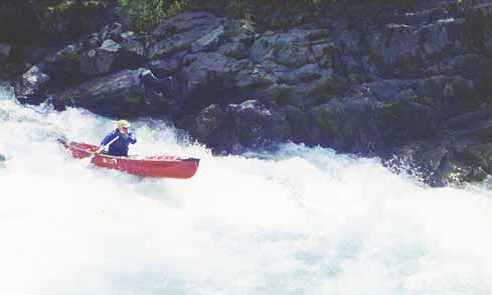 |
| Don Iverson, South Fork Falls, South Fork Smith River, CA. Photo by Tom Rydz |
Conclusion
Here, for the first time in history, we have codified 24 variably important but nonetheless distinct advantages of paddling an open canoe in whitewater. This treatise qualifies as the definitive academic reference by which the superiority of canoes is established and any claims to the contrary are refuted. Some kayakers may disagree, but have not published a convincing counterargument. We can expostulate the entirety of their case: canoes are harder to carry, occasionally retain moisture, are possibly harder to master, and are less maneuverable, making them less-suited for extremely difficult whitewater.
Points taken. Final score: 24 reasons for canoeing, 4 reasons for kayaking.
A rout by any standard. Quod erat demonstrandum. This work is dedicated to the people who have helped me learn the sport I love: Grandpa Don, my Dad, Kent Ford, my best friend Dr. Tom Rydz, the late Humboldt kayaking legend Dr. Jerome Lengyel, and those of his ilk, who catalyzed the writing of this thesis with their incessant ribbing; and, of course, my beloved wife and bow woman Terry Bean Iverson, the inspiration for reasons #11 and 13, but not #23. Don Iverson, South Fork Falls, South Fork Smith River, CA. Photo by Tom Rydz